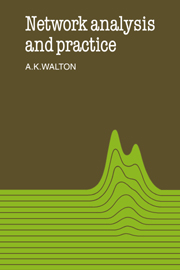Book contents
- Frontmatter
- Contents
- Preface
- 1 Electric charge, field and potential
- 2 Electric current, resistance and electromotive force
- 3 Direct-current networks
- 4 Capacitance, inductance and electrical transients
- 5 Introduction to the steady-state responses of networks to sinusoidal sources
- 6 Transformers in networks
- 7 Alternating-current instruments and bridges
- 8 Attenuators and single-section filters
- 9 Multiple-section filters and transmission lines
- 10 Signal analysis of nonlinear and active networks
- 11 Fourier and Laplace transform techniques
- 12 Filter synthesis
- Mathematical background appendices
- Problems
- Answers
- Solutions
- Index
12 - Filter synthesis
Published online by Cambridge University Press: 05 June 2012
- Frontmatter
- Contents
- Preface
- 1 Electric charge, field and potential
- 2 Electric current, resistance and electromotive force
- 3 Direct-current networks
- 4 Capacitance, inductance and electrical transients
- 5 Introduction to the steady-state responses of networks to sinusoidal sources
- 6 Transformers in networks
- 7 Alternating-current instruments and bridges
- 8 Attenuators and single-section filters
- 9 Multiple-section filters and transmission lines
- 10 Signal analysis of nonlinear and active networks
- 11 Fourier and Laplace transform techniques
- 12 Filter synthesis
- Mathematical background appendices
- Problems
- Answers
- Solutions
- Index
Summary
Introduction
An ideal filter would perfectly transmit signals at all desired frequencies and completely reject them at all other frequencies. In the particular case of an ideal low-pass filter, for example, the modulus of the transfer function, |J|, would behave as shown in figure 12.1(a). Up to a certain critical pulsatance ωc, |J| would be unity but above this pulsatance, |J| would be zero. Any practical filter can only approximate to such an ideal, of course.
In section 8.2 it was pointed out how |J|2 for a simple single-section L–R or C–R filter comprising just one reactive component only reaches a maximum rate of fall-off outside the pass band of 20 dB per decade of frequency compared with an infinite rate of fall-off for an ideal filter. Remember that the significance of |J|2 is that it indicates the power in the load for a fixed amplitude of input signal. Increasing the number of reactive components in the filter stage to two, as in the simple low-pass L–C filter of figure 8.7(a), causes |J|2 to reach a maximum rate of fall-off outside the pass band of 40 dB per decade of frequency. With n reactive components in the filter stage, the maximum rate of fall-off of |J|2 outside the pass band becomes 20n dB per decade of frequency and the filter is accordingly said to be of nth order.
- Type
- Chapter
- Information
- Network Analysis and Practice , pp. 278 - 288Publisher: Cambridge University PressPrint publication year: 1987



